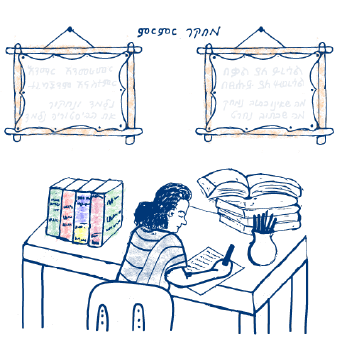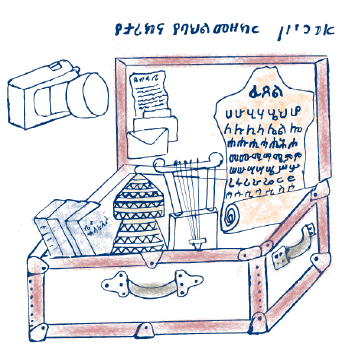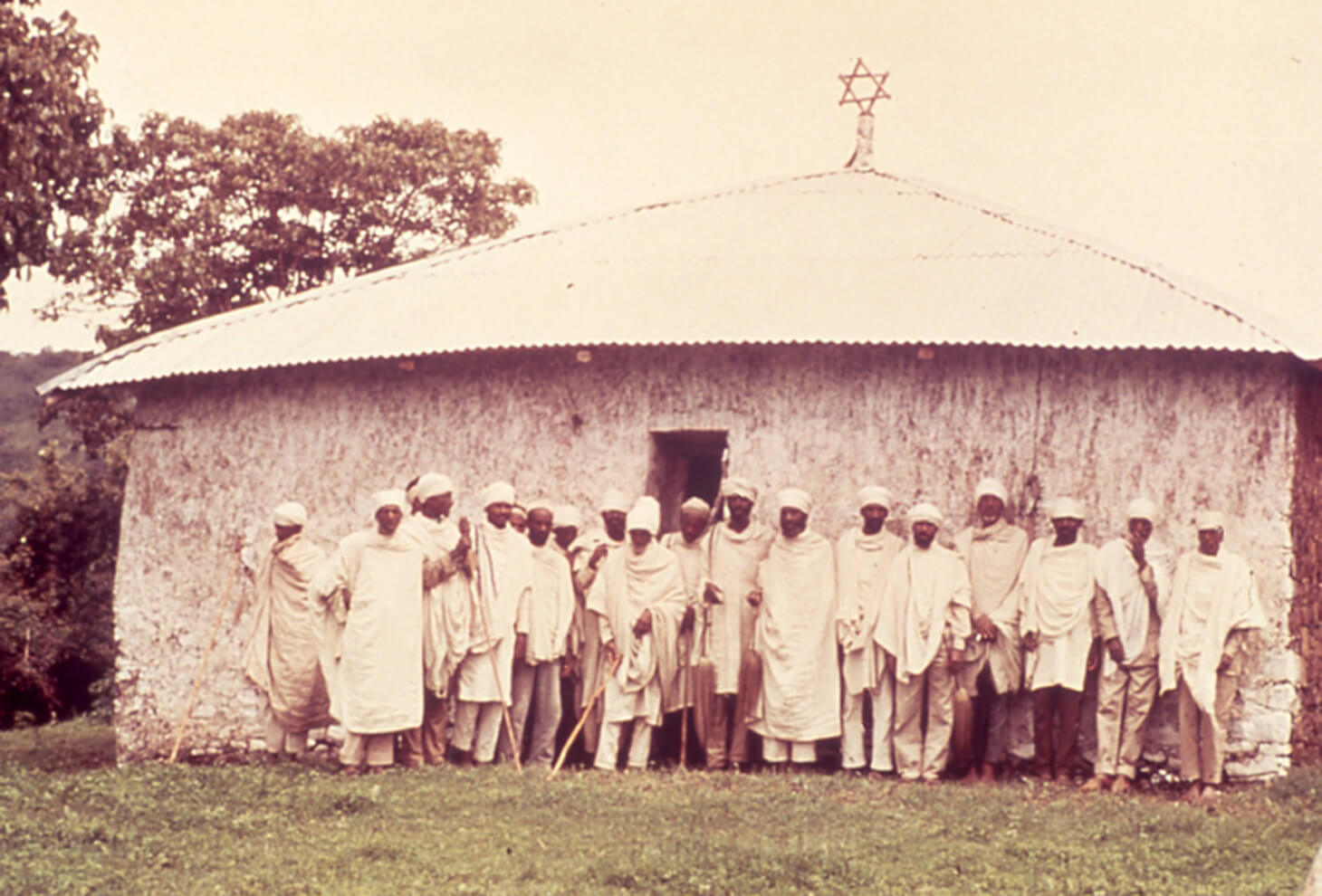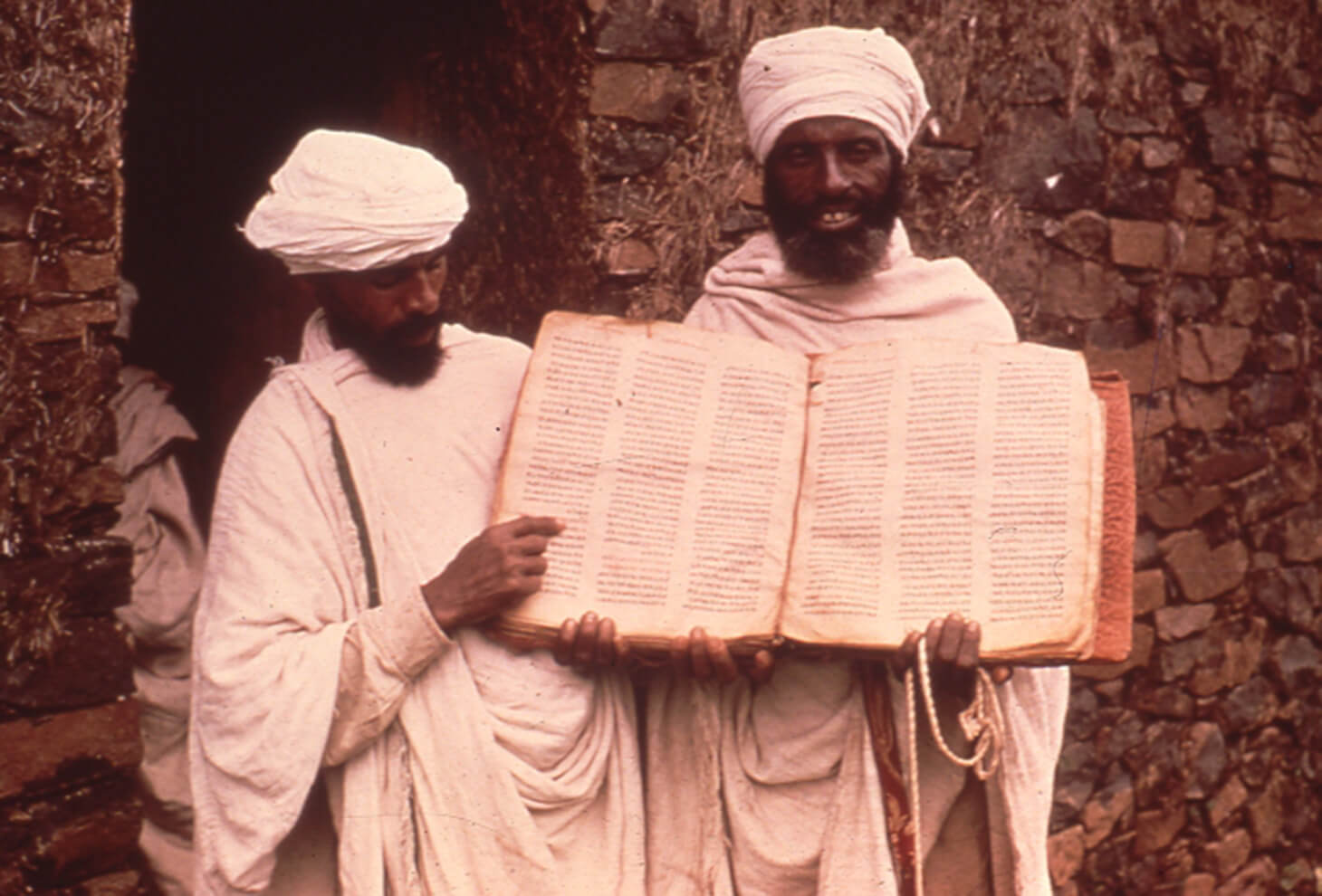
About Ethiopian Jewry
The Beginning of Jewish Settlement in Ethiopia
Until the 14th century, the history of the Jewish community in Ethiopia was hardly recorded at all in written form, but rather passed down orally from generation to generation. Therefore, the origins of the community and the date it reached Ethiopia are unknown. Throughout the years, several hypotheses were raised:
- The origins of the community (also known as Beta Israel) are from the tribe of Dan, which left the land of Israel during the expulsion of the Ten Tribes, or perhaps even earlier – when the Kingdom of Israel was split. The existence of a community of exiles in Cush appears as early as the Book of Prophets: “And it shall come to pass in that day, that the Lord will set His hand again the second time to recover the remnant of His people, that shall remain from Assyria, and from Egypt, and from Pathros, and from Cush […]. And He will set up an ensign for the nations, and will assemble the dispersed of Israel, and gather together the scattered of Judah from the four corners of the earth.” (Isaiah 11:11-12) It is notable that the book of Isaiah does not connect this community specifically to the tribe of Dan; the connection first appears in the writings of Eldad the Danite from the ninth century CE, and later in various rabbinical sources as well, such as the writings of the Radbaz (Rabbi David Ben Zimra). The former Chief Rabbi of Israel, Rabbi Ovadia Yosef, based his decision that the Jews of Ethiopia are indeed considered Jewish on this tradition.
- The community originated from Jews who emigrated from Egypt during various periods, beginning in the seventh century BCE, due to internal disputes within the Jewish community or because of external persecution. This hypothesis is based on traditions that are widespread within the community, and also supported by some scholars of Ethiopian Jewry, who point to the similarities between the customs of the ancient Jewish community in Yev (Elephantine), Egypt and the customs of the Beta Israel.
- The community’s ancestors did not emigrate from Egypt, but rather from southern Arabia (Yemen), where there was a significant Jewish community. This hypothesis, which is also common among scholars, is based on the geographic proximity between the two regions and the many testimonies of commercial and cultural ties between them, beginning from the fifth century BCE.
- The Ethiopian national tradition posits that the first members of the community arrived in Ethiopia during the era of King Solomon. This version expounds upon the Biblical reference to the meeting between King Solomon and the Queen of Sheba, saying that from this encounter, a son, named Menelik, was born and grew up in Ethiopia. As an adult, Menelik traveled to Jerusalem to visit his father, and at the end of the visit, he was sent back to Ethiopia accompanied by representatives from the tribes of Israel, from whom the community emerged. This tradition is part of the Ethiopian national epic, Kebra Nagast, and is also familiar among Beta Israel.
- The Beta Israel did not originate from an ancient Jewish community, but rather from Ethiopian Christians from the Agaw tribe who adopted Judaism at some time in the 14th-15th centuries. This hypothesis was raised in recent decades by a few scholars because, among other reasons, the chronicles of the Ethiopian rulers only mention the existence of Jews in their country starting from the 14th century. It should be noted that the community rejects this approach. In addition, most scholars are aware of the fact that the community lived in Ethiopia in ancient times, before Christianity even reached the country.
History of the Community up to the 19th Century
As aforementioned, the information available to us about the history of Ethiopian Jewry prior to the 14th century was preserved primarily by oral traditions. One of the main traditions is about a long period of autonomy under a dynasty of kings referred to as the “Gideonites.” The most famous of these rulers was Queen Yodit, who led an army of rebels who conquered the Christian Kingdom of Aksum in the 10th century and ruled for about 40 years. Reports of an Ethiopian Jewish autonomous community were publicized in the Middle Ages in Europe as well, in the writings of Eldad the Danite, mentioned above, in a book by the Jewish traveler Benjamin of Tudela, and more.
The first texts about the community that originated in Ethiopia itself were the chronicles of Ethiopian rulers. As of the 14th century, the chronicles include accounts of wars between the Jews of Ethiopia, who tried to retain their political and religious independence, and the Christian rulers. At the end of one of these wars, after the Jews were defeated, Emperor Yeshaq declared that anyone who did not convert to Christianity would lose their land. Most of the Jews refused to convert and were stripped of their land, and subsequently only allowed to cultivate land as tenant farmers. As a result, members of the community were forced to find alternate sources of income and began to engage in various crafts, especially blacksmithing and weaving (among the men) and embroidery and pottery-making (among the women). The fact that Jews engaged in these crafts increased the hostility displayed by their Christian neighbors, since they were considered lowly professions and blacksmithing was even perceived as connected to sorcery. These struggles between the Jews and the Christian rulership continued until the 17th century, when the community lost its independence completely.
Between 1888-1892, one of the most difficult catastrophes in the history of Ethiopia hit the country, taking a heavy toll among Beta Israel as well. During this period, known as Kifu-qen (“the terrible days”), a number of natural disasters and wars occurred, leading to a famine and plagues. The common estimate is that the Kifu-qen period resulted in the deaths of between one-third to two-thirds of Ethiopian Jewry.
Connection with Jews in the Diaspora
For most of the years of its existence, the Ethiopian Jewish community has been living in isolation from the rest of world Jewry. However, in the mid-19th century, the connection was forged, after European tourists and missionaries began to publicize information about them in Europe. At first, the connection was indirect, through an exchange of letters. In 1855, direct contact was also initiated when a representative of Beta Israel, Daniel son of Hananya, reached Jerusalem with his son and spent a few months with rabbis in the city.
The newfound connection with the community, as well as the vigorous activities of local missionaries, motivated Jewish organizations abroad to send emissaries to the region. The first emissary was Joseph Halevy, who arrived in Ethiopia in 1867, and he was followed about 30 years later by his student Jacques Faitlovitch, who dedicated his life to advancing the connection between the community and worldwide Jewry. Faitlovitch was involved in public relations campaigns, fundraising, battling the missionaries, and establishing educational infrastructures. Selected youth from Beta Israel were sent to study in Europe, and some later integrated into the Ethiopian government or served as leaders of the community. Some examples were Taamrat Emmanuel, Gete Yirmiahu, Yona Bogale, and Taddesse Yaqob.
During the first decades of the 20th century, the connection between Ethiopian Jewry and the Jewish and Zionist leadership became even stronger. For example, in the fifties, two groups of Ethiopian youth attended a training program in Kfar Batya for a few years, in order to then return to their communities and serve as teachers. However, the connection with the Israeli government did not lead to immigration to Israel until the seventies.
Immigration to Israel
Yearning for Zion had always been part of the community, as expressed in their songs, prayers, and the Sigd holiday. In 1862, this yearning let to a mass attempt to reach Jerusalem via the Red Sea, led by the spiritual leader Abba Mahari; a tragic attempt which ended in failure.
Slightly prior to the establishment of the State of Israel and during the first decade of its existence, a few families from the Beta Israel community immigrated to Israel, some arriving together with the Jews of Yemen. However, the state decided not to initiate immigration operations, among other reasons, due to the lack of consensus in Israel regarding the Jewish identity of the community (which also deprived it of the right to immigrate under the Law of Return). Furthermore, entities in the government voiced concerns regarding the ability of the Jews of Ethiopia to integrate into Israeli society socially and culturally.
Despite the state’s reservations, young adults from the community occasionally reached Israeli independently, posing as tourists or in order to work. Some were required to undergo pro forma conversion at some point, which made them eligible for new immigrant status. Others remained in Israel illegally, and were even issued deportation orders.
Following intense pressure placed by the community on the government, in 1973, the Sephardic Chief Rabbi of Israel at that time, Rabbi Ovadia Yosef, ruled that the Beta Israel community were Jewish. The state was not very quick in implementing this ruling, only applying the Law of Return to Ethiopian Jewry officially in 1975. Moreover, it continued its policy of refraining to actively advance the community’s immigration, and until 1977, there were only about 200 Ethiopian Jews living in Israel.
This small community worked tirelessly to bring Beta Israel to Israel, through petitioning, protesting, and holding meetings with government entities in Israel and worldwide. In addition, with the assistance of the American Association for Ethiopian Jews (AAEJ), a number of activists traveled around the world on PR campaigns, in order to increase awareness of the issue among foreign governments and Jewish communities in the Diaspora, who then put pressure on Israel.
The struggle for Ethiopian immigration finally bore fruit during the term of Menachem Begin, who put bringing the community to Israel on the national agenda. The first attempt was in 1977, when a secret deal was signed between Israel and Ethiopia, with whom Israel did not maintain diplomatic ties at the time. According to the deal, Israel was meant to supply military assistance to Ethiopia, in exchange for which approximately 200 Ethiopian Jews would be granted permission to immigrate to Israel on the grounds of family unification. After 121 olim had arrived, Israel’s foreign minister at the time, Moshe Dayan, exposed the deal to the media, and it was halted.
In 1979, Ethiopian immigration was renewed after activists such as Ferede Aklum, Baruch Tegegne, Zimna Birhane and Zecarias Yona managed to contact the Israeli Mossad. With the assistance of these activists, the infrastructure for a new route of immigration was laid. Tens of thousands of members of the community set out on the difficult journey to Sudan on foot. From there, they were secretly brought to Israel.
The journey took weeks and even months, and in the process, the olim had to hide from government soldiers and robbers, all while dealing with difficult terrain and conditions, as well as a lack of food and water. Upon reaching Sudan, the community members had to wait months or even years in refugee camps until the opportunity to immigrate arrived. The nutritional and sanitary conditions in the camps were subhuman, and the refugees suffered from harassment by the Sudanese authorities and the non-Jewish refugees. Many of those who hoped to reach Jerusalem were overcome by the difficult conditions and lost their lives on the journey or during the waiting period at the refugee camps. The estimate is that during these years, approximately 16,000 people reached Israel, while 4,000 perished on the way.
The Sudanese route to Israel was active for about a decade and was a joint operation of the Israeli Mossad, activists in the community, and the Israeli Air Force and Navy. It included operations of various sizes, the biggest of which was Operation Moses (November 21, 1984 - January 5, 1985). This operation, during which over 6,000 olim were brought to Israel, was the result of a secret deal signed with the Sudanese government and brokered by the United States. After about a month and a half, the operation was stopped, after Israeli entities leaked information to the media, which put the Sudanese government in a very awkward position. However, smaller-sized operations continued throughout the eighties. During these years, immigration activists in Israel continued to pressure the Israeli government not to lose sight of its efforts to bring the rest of Ethiopia’s Jews home.
At the end of 1989, the diplomatic ties between Israel and Ethiopia were renewed after a 16-year freeze, and Israel started to bring over members of the community directly from Ethiopia. Encouraged by activists from the community and Jewish organizations, most prominently the AAEJ, many people left their villages and gathered around the Israeli embassy in Addis Ababa. At first, their immigration was a slow process, to the dismay of the community in Israel. The latter put pressure on the Israeli government to expedite the process and unify families who had been separated after the immigration efforts via Sudan had ceased. The pressure increased as the security situation in Ethiopia gradually began to deteriorate, due to the raging civil war. Eventually, in April 1991, the decision was made to bring all of the residents of the complex to Israel urgently, as the rebels were approaching Addis Ababa.
The Israeli government began to prepare a complex immigration operation that was a joint effort of the IDF, Mossad, Foreign Ministry, Jewish Agency, and long-time Ethiopian olim in Israel. The operation, known as Operation Solomon, was launched on the night of May 23, 1991, and was the largest Jewish immigration operation in history. Over the course of 36 hours, 34 aircraft flew nonstop to bring over 14,000 olim to Israel.
After Operation Solomon, the state sent emissaries to the province of Qwara, which was difficult to access during the eighties as it had been overtaken by the rebels. Between 1992-1999, the residents of this province were also brought to Israel.
The last community to immigrate, and whose immigration essentially continues to this day, is the Zera Beta Israel community (also referred to as the Falash Mura or the remaining Jews of Ethiopia). The roots of this community were members of Beta Israel who converted to Christianity from the 19th century and onward, but did not assimilate with the general Christian population, instead remaining at somewhat of an interim status between the two communities. Sometimes, they even maintained their social connections with their Jewish relatives and the Jewish community in general.
The question of this community’s immigration is complex, since most of its members are not eligible for immigration under the Law of Return, but on the other hand, many of them have relatives from the Ethiopian community who already live in Israel. In addition, many of the members of the community undergo processes in Ethiopia to prepare for their conversion as they wait for a decision in their regard. Throughout the years, a number of waves of immigration were approved from the Zera Beta Israel community, facilitating the immigration of approximately 50,000 people. However, thousands still remain in Ethiopia, awaiting approval.
As of the end of 2020, there were approximately 159,500 people of Ethiopian descent in Israel, of which approximately 88,500 were born in Ethiopia and 71,000 were born in Israel.
Spiritual Leaders of the Beta Israel
The Kahanatotch (the Kessim) are parallel to the rabbis found in other Jewish communities. They were the ones who preserved the spark of the religion and guided their communities in Ethiopia. They possessed the knowledge of the Torah, commandments, and other religious matters. They conducted the religious ceremonies, and when necessary, used their influence to shape the community. Their proficiency in Torah and ethics won them respect as leaders both within their communities and externally. They were also involved in dispute resolution when theShmaglotch– community elders, were unable to reach a solution.
The Kes (Kahanat) began his religious studies at the age of seven or eight. He lived outside of the home with monks and would study consecutively until he took a proficiency test and was ordained. Ordination was only granted after he got married. After the Kes was ordained, the community had to choose him as the person appropriate to serve as their spiritual leader. The Kessim were presided over by the Lika Kahanat (High Kes) who was selected by all of the Kessim in the region and served as the supreme spiritual authority in the region.
The Kes could only marry a virgin woman and was not allowed to get divorced, except for under extreme circumstances and after receiving permission from senior Kessim, who were authorized to permit the divorce without damaging his status as a Kes. A Kes who became a widower was allowed to remarry, but only to a virgin woman, regardless of whether he was old or young. After the Kessim were ordained by the monks, an ordination ceremony was held in which senior Kessim from the village participated. The ceremony, which was a large public event, was accompanied by a festive meal, during which blessings were said and songs sung. The title of Kes is very important among Ethiopian Jewry. The Kessim lead the residents of the villages and rendered decisions according to the circumstances. Their role symbolized purity, integrity, respect, and pleasantness; they were role models in the communities where they served. The Kessim always wear white (symbolizing purity and cleanliness) and have a white turban on their heads, and they carry holy books with them.
The Kes has three main roles. One is connected to religious life, and includes leading prayer services during weekdays and on holy days, sacrificing offerings on festivals, ruling on matters of purity and impurity and marriage and divorce, and Torah study. The second role is a social one – the Kes preserves the social cohesiveness of the community. He settles dispute and arguments, and can even impose sanctions on those who behave improperly. The third role is to accept converts into the community. Since the Kessim usually did not work in agriculture like the other Jews, but rather dedicated their time to Torah study, they followed a modest lifestyle and were assisted by first fruits and donations given to them by the community. In every large village, there were Kessim who also served the members of the adjacent small villages.
An additional spiritual leadership role in the Beta Israel community belongs to the Melokusse - the monk. Beta Israel monasticism was instituted at a relatively late stage, beginning in the 15th century. The monks were people who took upon themselves to separate from community life and isolate themselves in order to study Torah. They safeguarded the secrets of the faith, as well as teaching and ordaining the Kessim.




